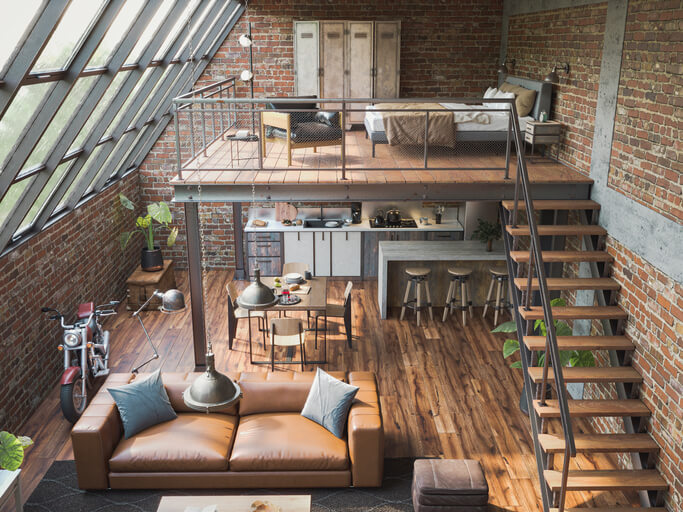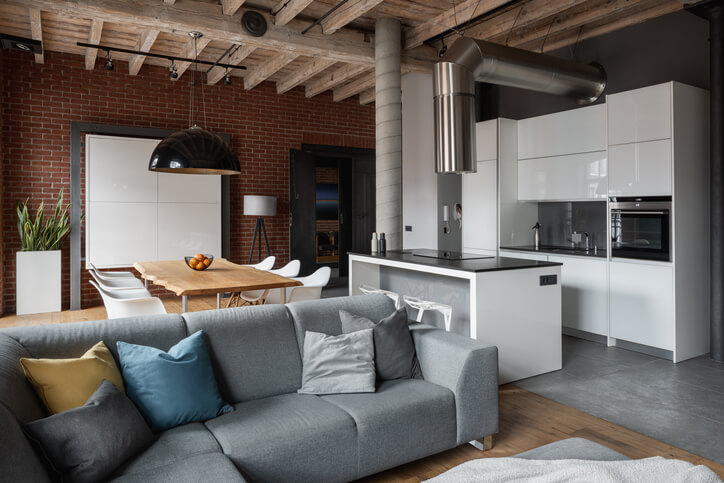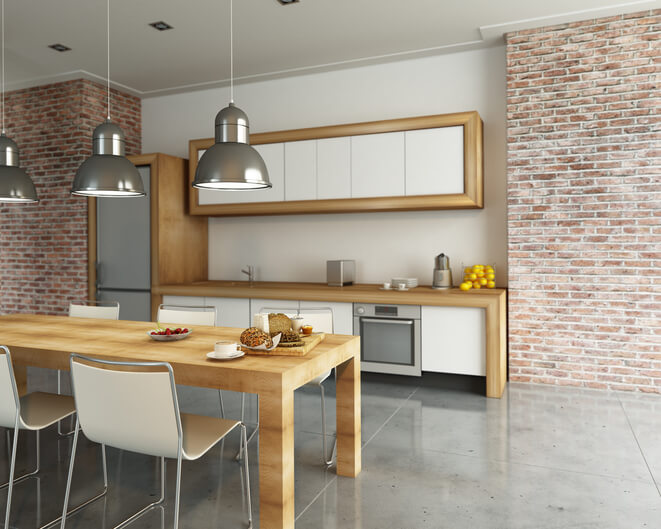Industrial kitchens are one of the top trends in kitchen decoration. One of its great advantages is that, with simple elements, a great result is achieved. But, to decorate a kitchen with this style, it is necessary to know what is based on the industrial style and know the keys to achieve the best result. We tell you the keys to the industrial style and give you some examples so that you can apply it to your kitchen.
What is the industrial style based on?
The industrial style originated in the United States, more specifically in the New York of the 40s and 50s, when artists sought their new homes in abandoned factories, with the intention of having a bright and spacious area.
From here, what we know today as a loft emerged, a type of very luminous housing with wide ceilings and ample spaces. These artists were looking for a place to grow as a person and as an artist that would not cost too much to buy or maintain.
Thus, the industrial style is based on simplicity and functionality, on pure lines and rounded shapes. This simplicity and the fact that artists and celebrities sought this type of construction for their homes, made the industrial style spread rapidly. As time went by, the industrial style crossed the pond, arriving in Europe as an original and new trend.

Essential elements and materials of the industrial style
Industrial kitchens fit perfectly with these two characteristics: simplicity and practicality. Although it may be thought that these kitchens have few elements and furniture, this is not usually the case. It is important, as in any design of any style, to have all the details well studied and have the design before carrying out the application of this style in any kitchen, both small and large. small or large kitchen.as well as large. The most important key to apply the industrial style are the materials and the most representative elements. Let’s see more about it.
Traditional industrial style materials
Because one of the keys to the industrial style are, precisely, the materials used. The fact of choosing abandoned factories as a place of residence, gave rise to the industrial style to use any type of material related to the industry, either for the floor, walls or ceilings. In fact, it is very common that one of these materials are the ones that are part of the final finish and the most visible part:
- Cement. Very recurrent in factories: cement walls and floors, with a rough and sloppy look that is often one of the identities of the industrial style.
- Brick. Leaving the brick exposed is very common, since many of the factories used as homes were not in good condition. Pecking the wall and leaving the brick exposed is a sign of identity.
- Wood. Wood is another of the materials used in factories at the beginning of the 20th century. That is why it is very common to see aged wood beams in any room.
- Other materials. Stainless steel, wrought iron or any type of metal is another of the hallmarks of industrial kitchens and of this style in general. Other interesting materials are:

Key elements of the industrial style
Other elements that are common in the industrial style are
- Roofs. Beams or pipes in sight.
- Worn furniture. Furniture recycling used elements, since a certain worn air mixed with wood, steel or lacquered doors are the most common.
- Doors. Even the doors can have a cement finish, to give more prominence to this material, very common in kitchens of this style.
- Appliances. Appliances with black or stainless steel finishes are ideal for unique kitchens.
- Colors. As for the most predominant colors in the industrial style, they are tiles, lead gray and bottle green, combining them with dark yellows and mustard to give a contrast. In combination with the modern style, it is very common to decorate an industrial style kitchen in gray and white, or in black and white.
- Decoration. Decorative objects often have a worn effect or even use recycled objects, without forgetting vintage pieces. To combine these characteristics it is common to find lamps and metal chairs.

Industrial kitchen ideas
Given all the characteristics of industrial kitchens, several ideas arise on how to decorate a kitchen to achieve the required finishes:
Microcement
Microcement creates an effect similar to that of cement, but it is an element that is better suited for houses.
- In an industrial style, it is possible to use this element to finish kitchen countertops.
- It is even possible to use it to finish kitchen furniture.
- An ideal combination would be countertops finished in microcement, with furniture in white finish, metal sink and a gas stove. Details like these will transport you back to those early New York industrial style lofts .
Brick
Brick is another element that fits perfectly in an industrial style kitchen.
- Depending on the construction of the house, it may be easier to have a brick wall, which can be left open to the air.
- If you do not have access to such a wall, it is possible to use wallpaper to decorate one of the kitchen walls.
- This, along with some furniture with cement or gray finishes, along with metallic lamps and chairs, will make the industrial style shine in your kitchen.
Wood
Aged wood is also another material widely used in industrial kitchens.
- In this case, it is possible to use it in places such as countertops or a central table.
- Untreated wood is ideal to get that used touch to a new piece of furniture. This, in combination with a brick wall and appliances in cement finish, adding the metallic touch in the lighting, is a great combination to get an industrial kitchen.
Lighting
The lighting, along with the décor and certain furnishings, are the icing on the cake.
- The lighting in industrial kitchens is usually metallic pendant lamps, even pendant lights with only the socket in sight.
- In this type of lamps it is very common to choose a bulb socket of a larger size than usual, where the light resistors make a decorative element.

Industrial kitchens are a trend that came from the United States and that, today, is a very demanded model when it comes to make a reform. Now that you know how to plan an industrial kitchen, do you dare to change yours? And if you want more inspiration, visit the Kitchens category of our blog Manos a la obra.



